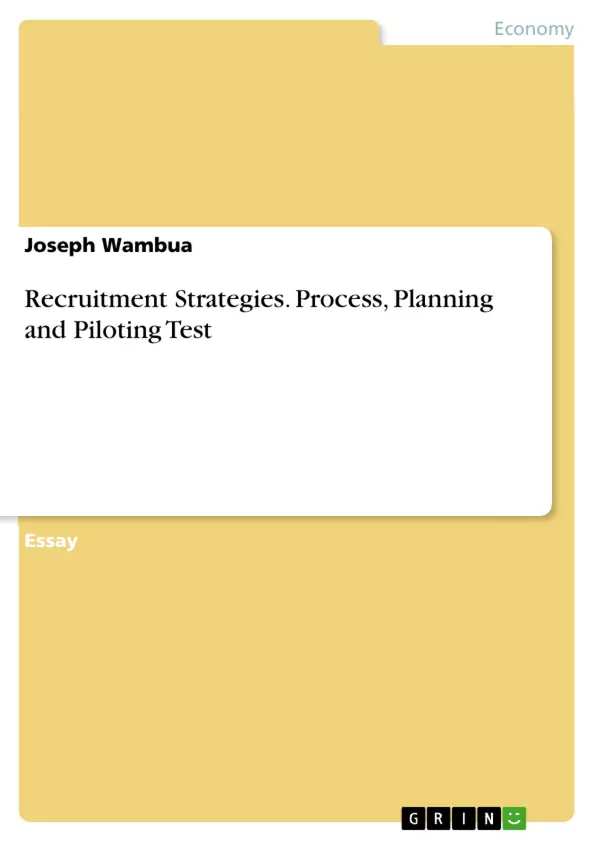The objective of this paper is to offer a comprehensive overview of the recruitment process, with a focus on its various elements, procedures, and the essential steps required to select the right candidates for organizational roles. The topics covered include recruitment planning, job analysis, and the development of effective pre-employment tests. The significance of recruitment in shaping the success of any business organization cannot be overstated.
Recruitment represents a fundamental aspect of any business organization's journey towards success. The ability to attract, select, and onboard the right talent can significantly impact an organization's capacity to meet its objectives, outperform competitors, and achieve substantial profitability. In today's competitive job market, the art of choosing the best candidates who align with the organizational needs, roles, and working environment is both a challenge and a necessity. This paper explores the intricate world of recruitment, shedding light on the procedure, test requirements, and the step-by-step process of creating empirically tested pre-employment tests.
The recruitment process is a multi-faceted journey that extends from the initial planning stage to the final selection of the right individuals for a given role. To accomplish this successfully, an organization must meticulously assess its needs, design job descriptions and specifications, and, most importantly, employ a rigorous testing methodology to evaluate the abilities and qualifications of potential candidates. After all, the quality an employee brings to the table is a decisive factor in determining an organization's success.
This paper breaks down the recruitment procedure into several key components. The intricacies of recruitment planning are explored, including the critical importance of analyzing job vacancies, job descriptions, and the qualifications, skills, and experience required for each position. A well-structured recruitment plan serves as a beacon, guiding potential candidates and helping them self-select based on their alignment with job requirements.
Recruitment, as will be seen, involves a systematic process that leaves no room for favoritism or arbitrary decision-making. A properly conducted recruitment procedure ensures that organizations secure candidates who can effectively fulfill their roles, satisfy management expectations, and, ultimately, enhance overall profitability.
Inhaltsverzeichnis (Table of Contents)
- Recruitment
- The Recruitment Procedure
- Recruitment Planning
- Strategy development
- Searching
- Screening
- Evaluation
Zielsetzung und Themenschwerpunkte (Objectives and Key Themes)
This document aims to provide a comprehensive guide to the recruitment process, focusing on the development of a pre-employment test to assess learning ability. The document outlines the steps involved in creating and implementing such a test, from initial planning and job analysis to testing and analysis of results.
- The importance of effective recruitment in achieving organizational goals.
- The steps involved in the recruitment process, including planning, strategy development, searching, screening, and evaluation.
- The critical role of job analysis in identifying necessary skills and qualifications for a position.
- The development and implementation of a pre-employment test to assess learning ability.
- The importance of ensuring the validity and reliability of assessment tools.
Zusammenfassung der Kapitel (Chapter Summaries)
- Recruitment: This chapter introduces the concept of recruitment and its importance in attracting and selecting qualified candidates for vacant positions. It highlights the challenges of finding the right employees and the benefits of outsourcing recruitment services.
- The Recruitment Procedure: This chapter outlines the five main steps of the recruitment process: planning, strategy development, searching, screening, and evaluation. It emphasizes the importance of a fair and transparent procedure.
- Recruitment Planning: This chapter focuses on the initial planning phase of recruitment, including job analysis, identification of required qualifications, and development of a clear recruitment plan. It discusses the impact of a well-structured plan on attracting qualified candidates.
Schlüsselwörter (Keywords)
The core focus of this text is on the recruitment process, with a particular emphasis on pre-employment testing for learning ability. Key terms include recruitment planning, job analysis, job specifications, recruitment strategy, pre-employment testing, personality tests, skills tests, test validity, and reliability.
- Citation du texte
- Joseph Wambua (Auteur), 2019, Recruitment Strategies. Process, Planning and Piloting Test, Munich, GRIN Verlag, https://www.grin.com/document/903637



